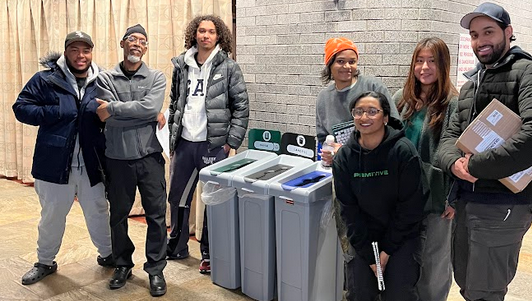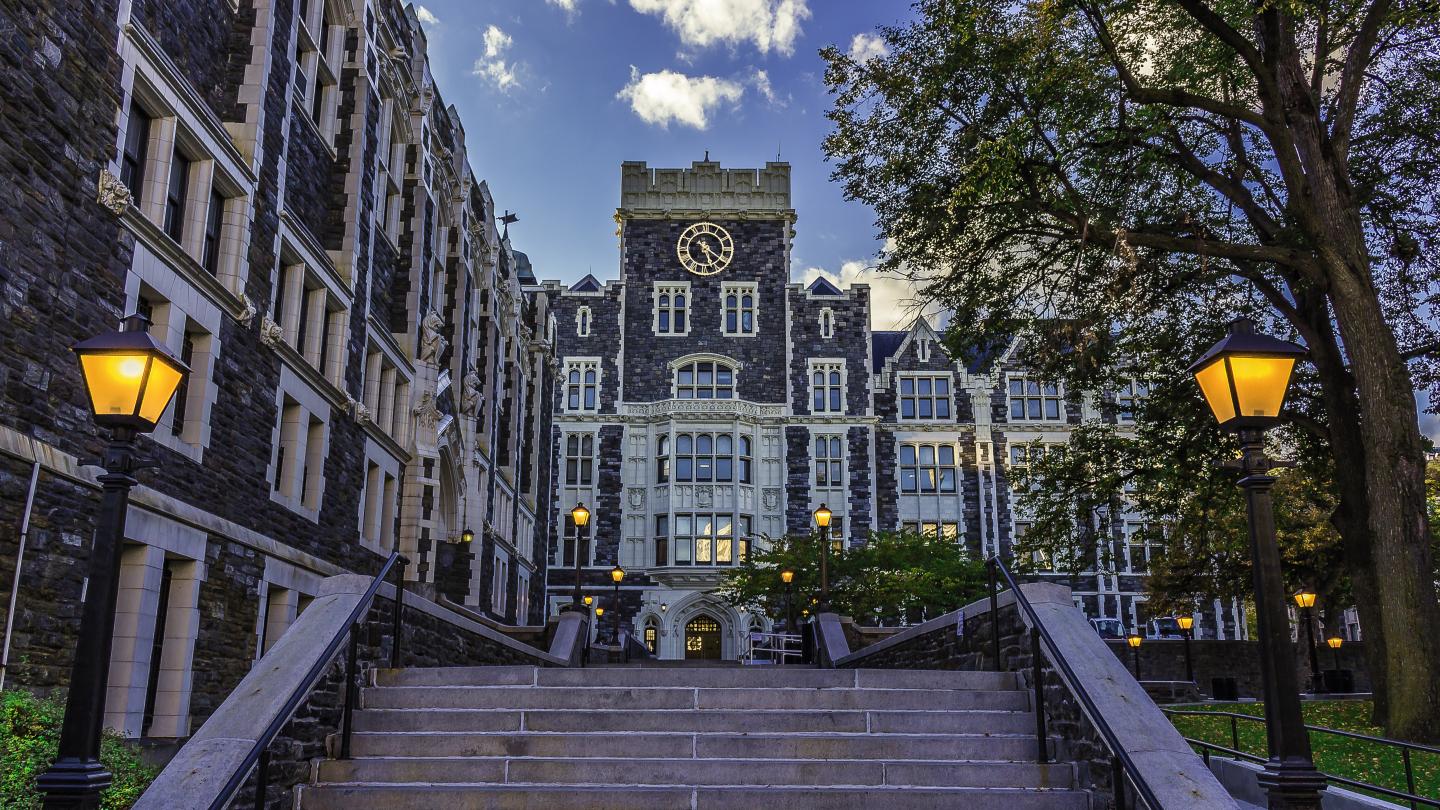Below is a more detailed outline of the paper’s main points:
Solid Waste Management Practices
Solid Waste Management refers to how CCNY, at the time of the paper’s publishing, dealt with what people throw away (both trash and recyclables.)

Typically, bins are separated by three waste streams:
- Trash — in gray.
- MGCPs (metals, glass, cartons, and plastics) — in blue.
- Mixed paper — in green.
While some recyclables (mixed paper and MGCPs) were indeed recycled, most recyclables were placed with general trash. CCNY does not currently have a set location to hold MGCPs to send to recycling plants. It was found by the Capstone Team that CCNY once had a designated location, but due to the lack of MGCP recycling on campus, CCNY abandoned this venture.

This is the total waste produced by CCNY from July 2022 to February 2023. It was calculated that, for this time period, the diversion rate from landfills and incineration plants was 25%.
This data was provided from the CCNY Facilities Department.
Whatever is put into the general trash, called “refuse” or “bulk waste” depending on size, is put into compactors or roll-on, roll-off (RORO) dumpsters. Once either is filled, the New York City Department of Sanitation (DSNY) is called for waste removal.

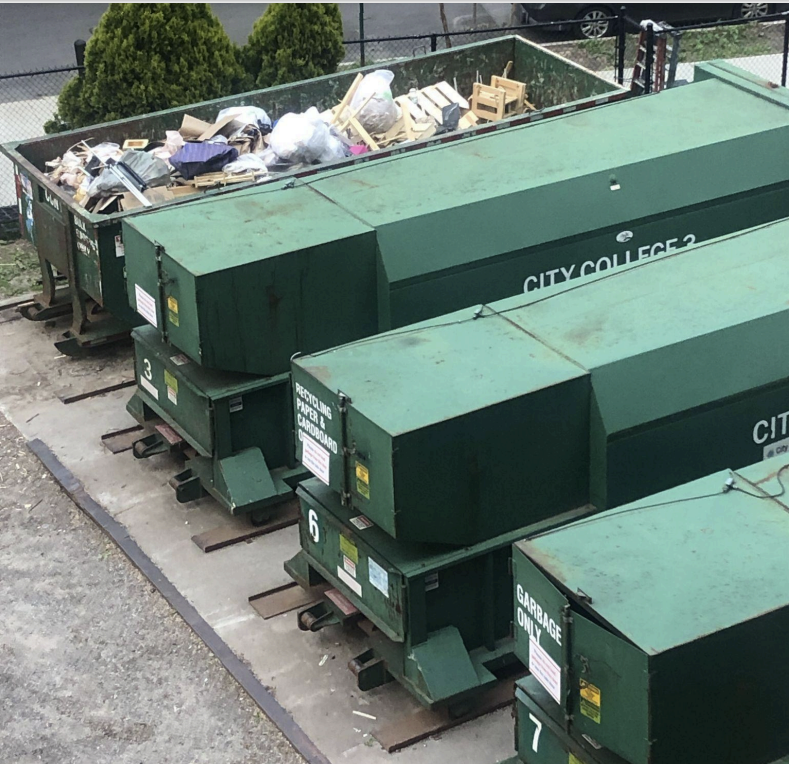
The map on the right shows where CCNY’s waste goes after collection:
- DSNY handles refuse and bulk waste (denoted in red and black) and sends this waste to two locations: Covanta Essex incineration plant in Newark, New Jersey and a private waste disposal company, respectively.
- Mixed paper (denoted in green) is sent to the Sims Municipal Recycling facility in Sunset Park, Brooklyn.
- Bulk metal here (denoted in blue) is a hypothetical situation: if CCNY did sort and collect MGCPs, they would be sorted at the same facility as mixed paper.
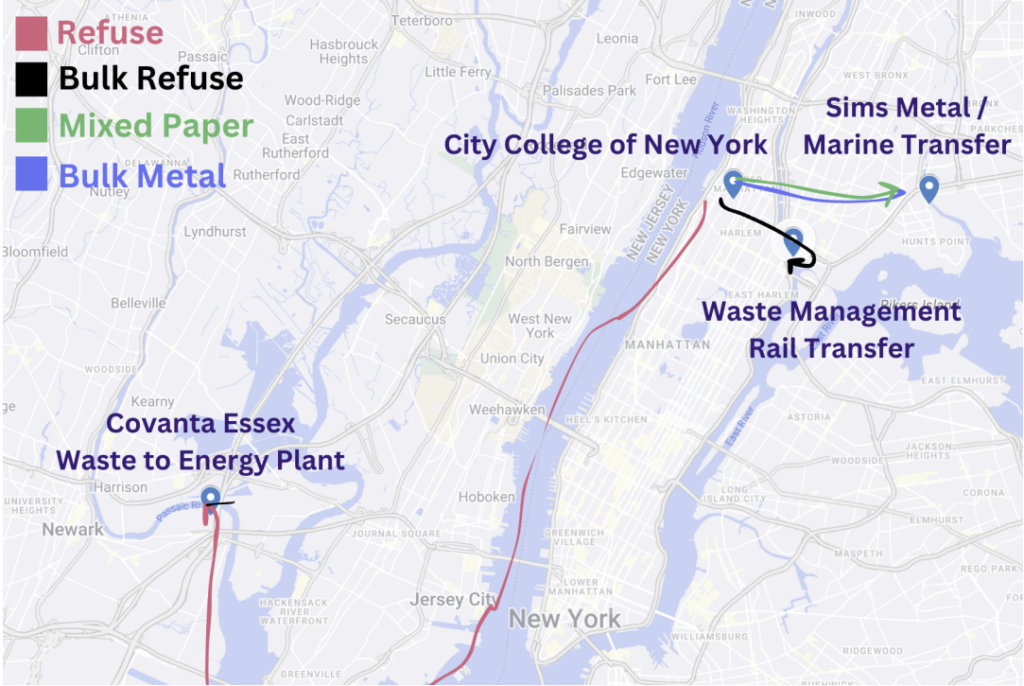
Moving Towards Responsible Materials Management
Responsible Materials Management (RMM) refers to CCNY’s efforts to promote sustainable actions on campus or use of eco-friendly items.
One of CCNY’s main RMM goals is to simply stop waste generated on campus from going to landfills. Instead, RMM aims for that waste to be reduced, reused, or recycled. This can take many forms including the encouragement of using hydration stations on campus to systems that refurbish and repurpose old office furniture, both of which CCNY has done.
Within the lens of RMM, the Team focused on the issue touched upon in the section above: the recycling practices of CCNY.

To understand how CCNY recycles, the Team worked closely with CCNY Facilities:
- The Team chose two areas to monitor in the North Academic Center (NAC) building: the 6th and 7th floors and the NAC rotunda.
- They conducted an initial waste audit: measuring the waste generated and categorizing which waste ended up in the right bin.
- Based on the results, the Team improved and installed waste bins and repeated the process.
A waste audit in progress is depicted on the right.
The results provided various perspectives on recycling on campus:
- Recycling needs on the 6th and 7th floors, where the most office space is, are highly variable: certain waste streams may be more overwhelmed on some weeks than others.
- When providing bins for certain waste streams, like compost, people often took the time to sort their waste.
- Those bins also decreased the waste ending up in general trash, meaning that more recyclables were actually being recycled.

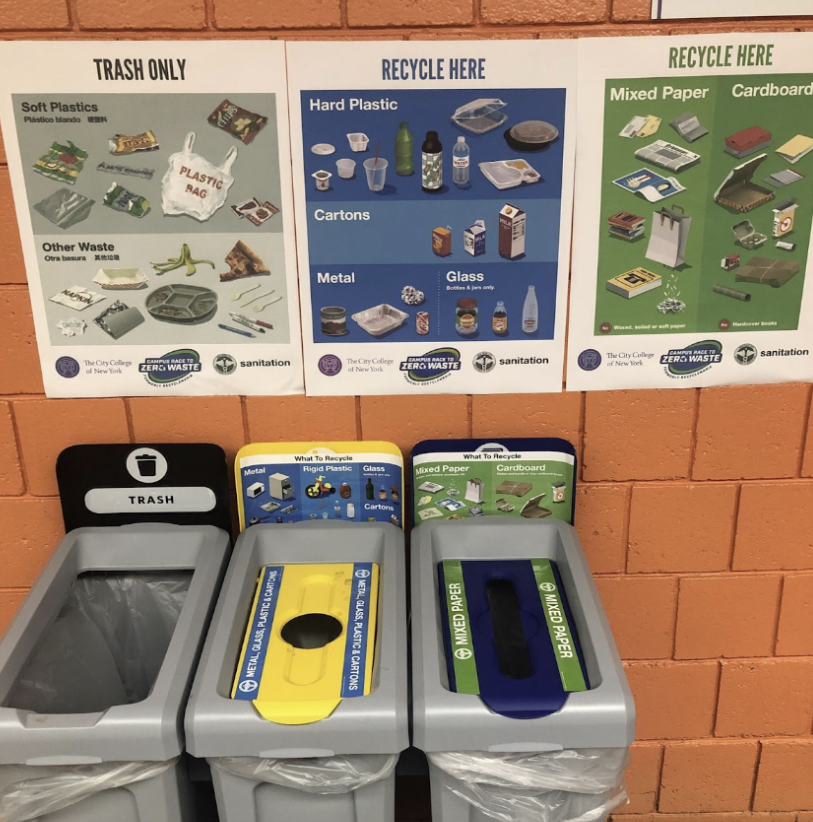
Energy Use and Efficiency Improvements
Energy use and efficiency improvements refers to conservation of energy on campus and improving the current system to be energy efficient.
Energy consumption is often the culprit when it comes to greenhouse gas emissions: the fuel providing the energy is derived from nonrenewable resources like oil or natural gas which releases greenhouse gases when used via burning.

Once those emissions enter the atmosphere, they excel in trapping excess heat from the sun which spurs climate change.
This short video on the left provides a visual for the description above.
In New York City, the biggest contributor of these emissions come from buildings getting their energy from those nonrenewable sources.
In response, NYC passed Local Law 97 to restrict those emissions due to energy consumption.
But this law allows exemptions for city-owned buildings (like CCNY’s campus).

Because of CCNY’s inherent exemption, the Team focused on what the campus is currently doing to be energy-conscious through two avenues:
| Energy Audit | Current Efforts |
|---|---|
| An energy audit conducted in 2010 highlighted many areas where CCNY could improve their energy consumption. Some notable results include: 1. Some of the various energy improvements around the campus can be completed within the next 5 years. 2. These improvements can greatly reduce greenhouse gas emissions. 3. They can also decrease the use of fossil fuels, better conserve energy, and overall lower the energy bill for CCNY. | CCNY’s current efforts spans mainly across two buildings: the NAC and Marshak Science buildings. Efforts include: 1. Upgrading the HVAC (heating, ventilation, and air conditioning) of the NAC. 2. Repairing the leaking issues in Marshak. 3. Installing submeters across campus to keep track of energy consumption. 4. Replacing all of CCNY’s incandescent bulbs with LED ones. 5. Installing a Building Management System to automatically manage energy consumption. |
Moving Towards Sustainable Campus Energy
Moving towards sustainable campus energy is about an entire campus shift towards greener energy sources. This differs from the last section by focusing on potential actions CCNY could take.
Knowing CCNY’s current sustainability status isn’t enough for change; CCNY must be actively pursuing change for there to be any. Bearing this in mind, the Team built off of the previous section by compiling future efforts CCNY can take surrounding greener energy.

Many organizations were brought in to propose efforts that CCNY could implement. Sustainable CUNY was one of these and suggested an effort that CCNY is currently implementing: replacing all incandescent lighting with LEDs.
The City University of New York (CUNY) is the university system CCNY is under while Sustainable CUNY is the organization supporting all sustainability efforts at CUNY colleges.
Other organizations — like Solar One, a company specializing in solar energy — aided the Team in realizing future energy-efficient actions CCNY could take. Some of those actions were:
- Implementing a Green Fee — CCNY currently has no financial allotment for sustainable projects on campus. This fee would be charged to the students at the start of every semester and provide the funding for those projects.
- Installing solar panels on the roof of the NAC building — this project is multifaceted: while providing a source of clean energy to the campus, a portion of it could be a clean energy option for nearby Harlem residents. It could also be used for engineering students to better understand renewable energy.
- Improve overall support — in order for any of these projects to be successful, faculty and students must be in favor for a more sustainable campus. The Team attempted to raise support via meetings (Decarbonizing CCNY) that aimed to raise student support.


Culture Change and Campus as a Living Laboratory
Campus change refers to a shift in the campus culture towards sustainability issues on campus while making campus a living laboratory refers to using the campus itself as a model of a greener college.
As groups on campus aim to change CCNY’s future into a more sustainable one, the Team looked at other colleges curating two things:
- A campus body that’s more involved in the campus’ sustainability issues.
- An interactive campus that’s an active ground for testing sustainability efforts.
The overarching aim is to connect the different parts of the campus body — departments, students, faculty — to commit to an overall sustainability efforts that will be seen through our campus attitude and building practices.

To make a potential plan for CCNY, the Team considered studying other successful campus models, like Columbia University’s. At Columbia, the goal is to use the campus itself as a model classroom for sustainability for the entire campus body. The image below is a visual breakdown of what Columbia is trying to implement.
Organizing for Sustainability
Organizing for sustainability is where the campus body gets involved: this section refers to our efforts to make CCNY’s campus more sustainable.
While building and department involvement is a crucial part of shifting CCNY to becoming more sustainable, the active participation of all parts of the campus body — students and faculty — to bring forth a more sustainable campus is needed. This participation is multi-faceted and ranges in what it looks like.
Overall, the main idea is to bring the campus body together under the same goal: making CCNY more sustainable.
Organizing can be doing a survey.
This is one of the easiest ways to get involved: making your voice heard. Many organizations survey to get input on a campus-wide issue. On the right, organizations have surveyed the campus body to gauge how well the campus is aware of CCNY’s sustainability status.


Organizing can be attending events that promote sustainability.
Various student and outside organizations on campus hold events that highlight topics that center on sustainability. By attending these events (like the PSA events held periodically), you’ll give reason for the event to continue educating the campus.
Organizing can be participating in student-run initiatives.
This is both a fun way to explore your interests and directly impact CCNY’s sustainability. And, like participating in the occasional events on campus, your presence can help keep these initiatives around for future students.

